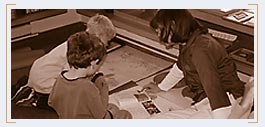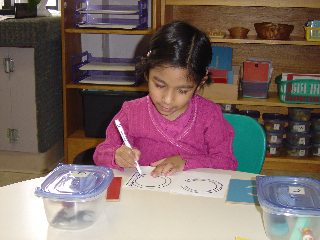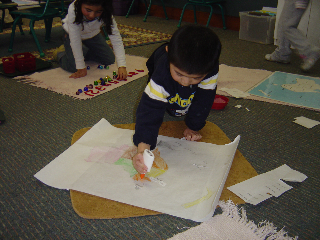Curriculum Outline
- Social skills and graces
- Self-care
- Care of environment
- Fine/gross motor skills
- Movement
- Sensorial
- Beginning geometry
- Numerals, sequencing and quantity
- Introduction to operations
- Basic art and music
- Language enrichment
- Phonetic and sight reading
- Integrated language development
- Writing
- Geography
- Introduction to science subjects and skills
|
Principles of Montessori
- Mixed-age grouping
- Gross and fine motor skill development
- Freedom of choice with responsibility
- Children progress at own pace
- Child-centered process
- Emphasis on self-discipline
- Positive behavior modeled and reinforced
- Respect for self means respect for others
- Children teach each other
- Appreciation and respect for all life
- Character development
- Individual as well as group instruction
- Self-teaching materials
- Emphasis on creative problem-solving
- Specially trained teachers
- Peace through education
- Individualized developmental learning
|
|
Montessori Compared to Traditional Education
The goal of Montessori and most traditional education is generally the same: to provide learning experiences for the child. However, a difference in emphasis and method makes this learning experience quite different in a Montessori classroom.
Montessori
|
Emphasis on whole-child development
|
Teacher is guide; children learn primarily from
self-correcting materials |
| Mainly individual instruction |
| Child moves at own pace |
| Curriculum adjusts to child's interests and needs |
| Child has large role in determining his work |
| Child moves and speaks at will |
| Child allowed to follow interests |
| Environment and methods encourage self-discipline |
| Child reinforces learning through repetition of work and internal feelings of success |
| Calm, orderly, beautiful work space |
Clear expectations and teaching related to
character development |
|
Traditional
| Emphasis on what a child can produce |
| Teacher is source of most information |
| Mainly group instruction |
| Pace is set by group norm |
| Child must adjust to curriculum |
| Child has little or no role in determining curriculum |
| Child's movement and expression are usually restricted and controlled by adult |
| Child generally allotted time per project |
| Teacher is source of discipline |
| Learning reinforced externally by rewards and critical feedback |
| High-stimulus, often chaotic, disorganized environment |
| Little emphasis on practical skills for proper behavior |
|





